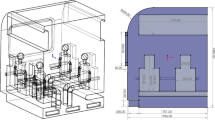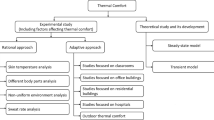Abstract
With the different physiological properties and thermal conditions, different body parts of passengers have inconsistent thermal sensations and thermal requirements in a highly non-uniform and transient vehicle cabin thermal environment. Determining the thermal comfort requirements for different body parts of a passenger is essential for effectively supplying warm air to the right human part especially for electric vehicles with energy-saving attributes. In this paper, a comprehensive numerical model that integrates human thermal regulation mechanism and dynamic environmental characteristics is established to calculate the thermal comfort for passengers via thermal responses to a dynamic environment. The numerical computation sets up such a model structure, firstly considering human thermal regulation functions into the thermal response to the in-cabin dynamic thermal distributions, then combining Berkeley thermal comfort model to identify the thermal comfort level at different body parts, that would implement total numerical simulations to get thermal comfort evaluation, independent of human subjective feedbacks. The model is validated by experiments with an acceptable error and implemented for a cabin heating case study. The models can effectively predict the thermal comfort and thermal requirements of various body parts in a dynamic environment with human thermoregulation, as an important tool for designing a non-uniform environment.
Similar content being viewed by others
Abbreviations
- c :
-
tissue heat capacity, J/kg/K
- c b1 :
-
heat capacity of blood, J/kg/K
- C overall :
-
overall thermal comfort, dimensionless
- Cs :
-
vasodilation, W/K
- Dl :
-
vasoconstriction, W/K
- k :
-
tissue conductivity, W/m/K
- q m :
-
metabolic heat generation, W/m3
- q m,0 :
-
basal metabolic rate, W·m3
- r :
-
radius, m
- Sh :
-
shivering, W
- Sw :
-
sweating, g/min
- S overall :
-
overall thermal sensation, dimensionless
- t :
-
time, s
- T bl,a :
-
arterial blood temperature on right side, °C
- TC i :
-
local thermal comfort, dimensionless
- th :
-
thickness, mm
- T hy :
-
core temperature, °C
- ∆T hy :
-
changing of core temperature, °C
- TS i :
-
local thermal sensation, dimensionless
- T sk :
-
skin temperature, °C
- ∆T skin :
-
changing of skin temperature, °C
- dT skin/dt :
-
rate of mean skin temperature, °C/s
- T t :
-
tissue temperature, °C
- w bl :
-
blood perfusion rate, 1/s/m3
- ω :
-
geometry factor, dimensionless
- ρ :
-
tissue density, kg/m3
- ρ bl :
-
blood density, kg/m3
References
Al-Othmani, M., Ghaddar, N. and Ghali, K. (2008). A multi-segmented human bioheat model for transient and asymmetric radiative environments. Int. J. Heat and Mass Transfer 51, 23–24, 5522–5533.
Chen, J., Zheng, X. and Lan, F. (2019). An analysis on thermal comfort in passenger compartment based on human thermal regulation model. Automotive Engineering, 41, 6, 723–730.
Davoodi, F., Hassanzadeh, FL, Zolfaghari, S. A., Havenith, G. and Maerefat, M. (2018). A new individualized thermoregulatory bio-heat model for evaluating the effects of personal characteristics on human body thermal response. Building And Environment, 136, 62–76.
Ding, X. J. (2009). An introduction to the effect of garment thermal resistance on human thermal comfort. Construction Conserves Energy 37, 216, 27–29.
Fiala, D., Lomas, K. J. and Stohrer, M. (1999). A computer model of human thermoregulation for a wide range of environmental conditions: The passive system. J. Applied Physiology, 87, 1957–1972.
Fiala, D., Lomas, K. J. and Stohrer, M. (2001). Computer prediction of human thermoregulatory and temperature responses to a wide range of environmental conditions. Int. J. Biometeorology 45, 3, 143–159.
Ghali, K., Ghaddar, N. and Salloum, M. (2008). Effect of stove asymmetric radiation field on thermal comfort using a multisegmented bioheat model. Building and Environment 43, 7, 1241–1249.
Guo, H., Zha, Q., Cai, H. and He, D. (2017). An evaluation method of thermal comfort of the in-vehicle cab based on the PMV model and FCM algorithm. J. Zhejiang University of Technology 45, 5, 556–561.
Han, T. and Chen, K. (2009). Assessment of various environmental thermal loads on passenger compartment soak and cool-down analyses. SAE Paper No. 2009-01-1148.
Han, T., Chen, K., Khalighi, B., Curran, A., Pryor, J. and Hepokoski, M. (2010). Assessment of various environmental thermal loads on passenger thermal comfort. SAE Paper No. 2010-01-1205.
Han, T. and Huang, L. (2004). A model for relating a thermal comfort scale to EHT comfort index. SAE Paper No. 2004-01-0919.
Khatoon, S. and Kim, M. (2017). Human thermal comfort and heat removal efficiency for ventilation variants in passenger cars. Energies 10, 11, 1710.
Lee, D. and Lee, H. (2019). Numerical study of preventilation effects on cabin temperature using solar sunroof. Int. J. Automotive Technology 20, 6, 1173–1181.
Li, Y., De, L. R. J. and Gong, Y. (2018). The smart thermostat of HVAC systems based on PMV-PPD model for energy efficiency and demand response. 2nd IEEE Conf. Energy Internet and Energy System Integration (EI2), Beijing, China.
Lü, H. B., Chen, B., Gao, T. Y., Li, Y., Si, J. and Chen, J. (2020). Analysis on thermal comfort in car passenger compartment based on flow field and temperature field. Qiche Gongcheng/Automotive Engineering 42, 2, 234–239.
Liping, P., Mengmeng, G., Jun, W. and Yi, C. (2012). Aircraft cabin comfort analysis with human thermoregulation model. J. Beijing University of Aeronautics and Astronautics 38, 2, 166–169, 174.
Song, C., Liu, Y. and Liu, J. (2018). The sleeping thermal comfort model based on local thermal requirements in winter. Energy and Buildings, 173, 163–175.
Tanabe, S., Kobayashi, K., Nakano, J., Ozeki, Y. and Konishi, M. (2002). Evaluation of thermal comfort using combined multi-node thermoregulation (65MN) and radiation models and computational fluid dynamics (CFD). Energy and Buildings 34, 6, 637–646.
Zhang, H., Arens, E., Huizenga C. and Han, T. (2010a). Thermal sensation and comfort models for non-uniform and transient environments, Part I: Local sensation of individual body parts. Building and Environment 45, 2, 380–388.
Zhang, H., Arens, E., Huizenga, C. and Han, T. (2010b). Thermal sensation and comfort models for non-uniform and transient environments, Part II: Local comfort of individual body parts. Building and Environment 45, 2, 380–388.
Zhang, H., Arens, E., Huizenga, C. and Han, T. (2010c). Thermal sensation and comfort models for non-uniform and transient environments, Part III: Whole-body sensation and comfort. Building and Environment 45, 2, 399–410.
Zhang, W., Chen, J. and Lan, F. (2014). Experimental study on occupant’s thermal responses under the non-uniform conditions in vehicle cabin during the heating period. Chinese J. Mechanical Engineering 27, 2, 331–339.
Zhou, X., Lai, D. and Chen, Q. (2019). Experimental investigation of thermal comfort in a passenger car under driving conditions. Building and Environment, 149, 109–119.
Zhou, X., Lian, Z. and Lan, L. (2013). An individualized human thermoregulation model for Chinese adults. Building and Environment, 70, 257–265.
Zhou, X., Zhang, H., Lian, Z. and Zhang, Y. (2014). A model for predicting thermal sensation of Chinese people. Building and Environment, 82, 237–246.
Acknowledgement
This research was funded by the National Natural Science Foundation of China (Grant No. 51775193) and Science and Technology Planning Project of Guangdong Province (Grant No. 2015B010137002).
Author information
Authors and Affiliations
Corresponding author
Additional information
Publisher’s Note
Springer Nature remains neutral with regard to jurisdictional claims in published maps and institutional affiliations.
Rights and permissions
About this article
Cite this article
Li, W., Chen, J., Lan, F. et al. Numerical Projection on Occupant Thermal Comfort via Dynamic Responses to Human Thermoregulation. Int.J Automot. Technol. 23, 193–203 (2022). https://doi.org/10.1007/s12239-022-0016-z
Received:
Revised:
Accepted:
Published:
Issue Date:
DOI: https://doi.org/10.1007/s12239-022-0016-z




